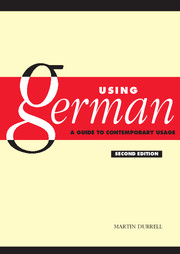1 - Varieties of language
Published online by Cambridge University Press: 05 June 2012
Summary
German is spoken as a native language by about 100 million people in at least fifteen European countries. This constitutes by far the largest speech community in Western and Central Europe. It is an official state language in Germany, Austria, Switzerland, Liechtenstein and Luxembourg. It has recognized regional status in areas of Belgium, Denmark, Italy and Romania and, even after the expulsion and resettlement of large numbers of German speakers after the Second World War, it still accounts for sizeable long-established minorities in France, Hungary, Poland, the Czech Republic, Slovakia and Russia. It also has a vast range in terms of possible uses: for everyday conversation, formal speech, technical writing, journalism, literature (in the widest sense), and so on.
Given this broad geographic spread and the number of uses to which it is put, it is quite natural that it is subject to considerable variation. Different words, grammatical constructions and sentence types are used depending on who is speaking or writing, to whom, on what topic, in what circumstances, in what region. Most people can choose to speak formally or informally as they feel appropriate in a given situation. Students, for instance, express themselves in very different ways when discussing politics or sport with friends in a cafe, talking to their parents or a lecturer, writing a seminar paper or a letter of application for a job.
Information
- Type
- Chapter
- Information
- Using GermanA Guide to Contemporary Usage, pp. 1 - 51Publisher: Cambridge University PressPrint publication year: 2003
